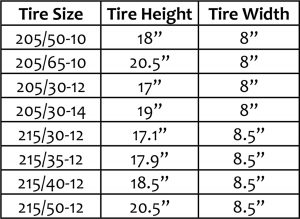The Golf Car Owner’s Guide To Buying Tires
One of the most common questions that I am asked by customers of WHEELZ Custom Carts is, “How do I know which wheels and tires I should buy?” It seems that something so simple and common as tires should not present such a challenge to golf car owners, but it can be surprisingly tricky. So, I have come to the rescue to help golf car owners across the country answer this question for themselves with a crash course.
• How Do You Use Your Golf Car?
The first step in choosing the appropriate tires is to identify how your golf car is primarily used. Here are a few guidelines:
Golf Course: Look for a turf or street tire. The rubber is softer and the tread is shallow, so the tires will not damage the golf course.
Street: If most of your driving is on the street, you may opt for a radial tire. Radial tires have cord plies that are arranged at 90 degrees to the direction of travel.
Trail: Offroad tires with more aggressive, thicker tread are preferred when gravel or dirt trails are your terrain of choice.
Now that you have decided on the type of tire, let’s move on to size.
• What Size Golf Car Tire Is Right for You?
Golf car tire sizes can look like a jumbled mess of numbers at first glance, but, I promise, it makes sense.
Here is the formula for an offroad tire:
22×10-12- The first number is always the height (or diameter) of the tire. The second number is the tire width and the third number is the size of the wheel. So, in this example, the tire is 22” tall and the width is 10” wide. The wheel for this tire is 12” in diameter.
It is a bit different for a turf or street tire, as they are sized similarly to vehicle tires:
215/50-12- This first number is the width of the tire in millimeters. The second number is the ratio of the sidewall to the width. So, divide the first number by this number to determine the ratio. Basically, bigger ratios are meatier tires and smaller ratios have a lower profile. The last number, 12, is still the wheel size that the tire will accommodate.
Since turf and street tires are a bit trickier to calculate size, here is a quick reference chart with some of the most common sizes:
 In general, stock E-Z-GO golf cars can accommodate up to 20” tires without rubbing, but stock Club Cars and G Series Yamaha’s will rub at 19”. Newer Yamaha DRIVE model golf cars can fit a 20” tire. If your golf car has a rear seat kit, cargo box, or an older, worn out suspension, you may need to go smaller with the tires or install a lift kit.
In general, stock E-Z-GO golf cars can accommodate up to 20” tires without rubbing, but stock Club Cars and G Series Yamaha’s will rub at 19”. Newer Yamaha DRIVE model golf cars can fit a 20” tire. If your golf car has a rear seat kit, cargo box, or an older, worn out suspension, you may need to go smaller with the tires or install a lift kit.
• Tire Buying Glossary
Before shopping for golf car tires, brush up on these common terms:
Radial: Radial tires have cord plies that run perpendicular to the direction of travel. Many street tires are radial.
Tread Depth: The vertical measurement between the top of the tread rubber to the bottom of the deepest groove is the tread depth.
Low Profile: Low profile tires typically accommodate bigger wheels and have skinnier sidewalls.
All Terrain: Similar to offroad tires, all terrain tires have a deeper, more rugged tread. They are not typically permitted on golf courses and can be noisy on the street.
Ply: A tires ply or load rating speaks to the thickness of the rubber and the subsequent load that can be carried.
About the Author: The Founder/Former Owner of WHEELZ Custom Carts & Accessories, Julie Starr, was one of the industry’s first online retailers of golf car products. The eCommerce store, www.WHEELZLLC.com, has served golf car owners since 2008 and remains a popular online shopping experience for golf car owners who want to take their golf cars to the next level.



